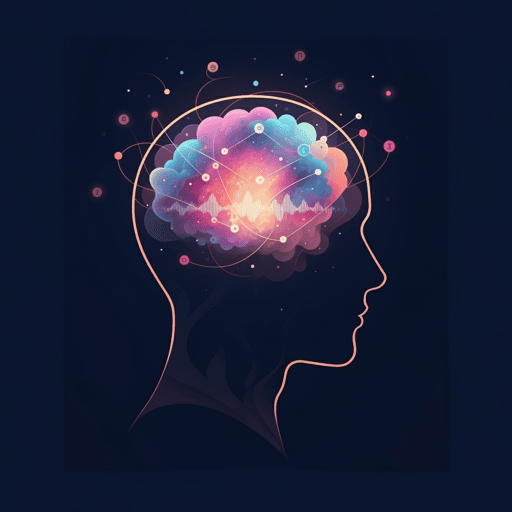
Psychology
Mind wandering during implicit learning is associated with increased periodic EEG activity and improved extraction of hidden probabilistic patterns
P. Simor, T. Vékony, et al.
Mind wandering—occupying 30–50% of waking time—may boost, not harm, certain learning. Using EEG and an implicit probabilistic learning task in healthy adults, the authors found spontaneous mind wandering and low-frequency, sleep-like cortical activity improved extraction of hidden visual probabilities, especially early in learning. This research was conducted by Authors present in <Authors> tag.
~3 min • Beginner • English
Introduction
Mind wandering frequently impairs performance on attention-demanding, model-based tasks, yet it constitutes a substantial portion of waking mentation. Prior work shows benefits of mind wandering for creativity and problem-solving, suggesting potential advantages when tasks demand minimal executive control. Probabilistic (statistical) learning is model-free, proceeding automatically without explicit awareness or focused attention, allowing extraction of environmental regularities via mere exposure. Recent evidence hints that lapses of attention may facilitate learning of hidden contingencies, and an online ASRT study found improved probabilistic learning but reduced visuomotor accuracy during mind wandering. EEG studies link mind wandering to attenuated sensory processing and slow-frequency activity reminiscent of sleep, raising the possibility that transient offline states during wake may support consolidation-like processes. The present study aimed to test whether mind wandering benefits implicit probabilistic learning, characterize its electrophysiological (aperiodic and periodic) correlates during task performance, and assess whether mind wandering and probabilistic learning share overlapping EEG features.
Literature Review
Extensive literature demonstrates that mind wandering degrades performance in sustained attention, executive control, reading comprehension, and explicit sequence learning. Conversely, mind wandering has been associated with enhanced performance in creative incubation and insight problem solving, particularly when task demands are low or rules are unclear. Probabilistic learning enables implicit acquisition of statistical dependencies without awareness or focused attention and can be measured with the ASRT task, which assesses both predictive statistical learning and visuomotor performance. Prior work (Decker et al., 2023) suggested attentional lapses facilitate learning of hidden contingencies, and an online ASRT study (Vékony et al., 2023) showed mind wandering improved probabilistic learning but impaired visuomotor accuracy. EEG findings on mind wandering include decreased evoked potentials (reduced sensory processing), increased slow/delta activity (sleep-like/local sleep), and modulations in theta and alpha power. Additionally, parameterizing EEG spectra into aperiodic and periodic components (FOOOF) provides sensitive indices of brain states, attention, and cognition.
Methodology
Participants: 37 right-handed university students (mean age 22.1 ± 1.27 years; 30 females) without psychiatric, neurological, or chronic somatic disorders, normal/corrected vision, and no relevant medication. Ethics approval was obtained (Eötvös Loránd University); informed consent was given.
Procedure: Sessions occurred between 12:00–14:00. After EEG setup (64 channels), participants received instructions and a quiz on mind wandering probes. After two practice blocks with random stimuli, they completed 30 ASRT blocks (80 trials each; plus 5 warm-up random trials). After each block, participants answered three thought probes assessing: (Q1) focus vs. mind wandering, (Q2) mind wandering content vs. mind blanking, (Q3) spontaneous vs. deliberate attentional state (each on 4-point scales). Performance feedback (mean speed, accuracy) was presented after probes. Awareness checks confirmed no explicit knowledge of the alternating sequence.
ASRT task: Central arrow stimuli (up/down/left/right) presented for 200 ms, followed by a 500 ms response window (fixation cross), then 750 ms fixed ISI. Incorrect or missing responses triggered feedback symbols (500 ms). Stimuli followed an 8-element alternating probabilistic sequence (pattern and random elements; 24 possible sequences counterbalanced across participants). Triplets (runs of three consecutive elements) were categorized as high-probability (62.5% of trials) or low-probability (37.5%). Behavioral measures: Probabilistic Learning = difference in accuracy/RT for the last element of high- vs. low-probability triplets; Visuomotor Performance = overall accuracy/RT regardless of triplet probability. Exclusions: trills/repetitions, first two trials, RT >1000 ms, and inaccurate trials for RT analyses.
EEG recording/preprocessing: 64-channel BrainAmp system; initial reference FCz, re-referenced to mastoids; EOG channels monitored eye movements; EMG on chin; impedances <10 kΩ; sampling rate 1000 Hz; antialiasing and notch filters applied. Data band-pass filtered 0.3–70 Hz (Butterworth, zero-phase). ICA identified cardiac/ocular/muscle artifacts (2–4 components removed). Additional artifact rejection via FieldTrip ft_artifact_zvalue with visual confirmation.
EEG spectral decomposition: Artifact-free data segmented into 2-s non-overlapping windows. Multitaper FFT (DPSS) computed PSD 1.5–40 Hz (0.5 Hz resolution), averaged per block/participant. FOOOF separated aperiodic (spectral slope/exponent) and periodic oscillatory components. Periodic band powers computed: Slow (1.5–2 Hz), Delta (2.5–4 Hz), Theta (4.5–8.5 Hz), Alpha (9–13.5 Hz), Beta (14–30 Hz).
Statistical analyses: Linear Mixed Models (LMMs) with random intercepts and, where feasible, random slopes by participant examined within-person associations. Predictors were mean-centered within participants. Models assessed: (i) learning/visuomotor performance over blocks; (ii) temporal changes in mind wandering; (iii) associations between mind wandering and performance; (iv) associations between EEG (aperiodic/periodic) activity and mind wandering or probabilistic learning, controlling for Block. Channel-wise analyses used FDR correction (Benjamini-Hochberg) with significance at q<0.05. First vs. second half (Blocks 1–15 vs. 16–30) were analyzed separately for EEG-behavior links due to time-dependent effects.
Key Findings
• Mind wandering increased over time: LMM showed a main effect of Block on Q1 (mind wandering vs. task focus) with greater mind wandering in later blocks (b = -0.13, 95% CI [-0.19, -0.06], t = -4.19, p < 0.001); GLMM with dichotomized scores corroborated (OR = 0.69, 95% CI [0.61, 0.78], t = -6.3, p < 0.001).
• Learning trajectories: Probabilistic Learning (accuracy difference high- vs. low-probability trials) increased with practice (Block: b = 0.045, 95% CI [0.016, 0.075], p = 0.003), while Visuomotor Accuracy (overall accuracy) decreased (Block: b = -0.043, 95% CI [-0.064, -0.021], p < 0.001). RT-based indices showed faster responses over time and greater differentiation for high vs. low probability trials.
• Mind wandering benefits probabilistic learning: Accuracy-based Probabilistic Learning was higher during mind wandering vs. task focus (Table 1: MW vs. Task Focus estimate -1.262, 95% CI [-2.005, -0.519], t = -3.332, p = 0.001; coding indicates more mind wandering linked to better probabilistic learning). A Block × MW interaction (b = 0.071, 95% CI [0.028, 0.111], p = 0.001) showed stronger benefits in earlier task phases. Splitting the task: MW × time-half interaction was significant (b = 0.88, 95% CI [0.13, 1.63], p < 0.02); the positive MW–learning association held in Blocks 1–15 (b = -0.576, 95% CI [-1.09, -0.06], p = 0.029) but not in Blocks 16–30 (p = 0.26).
• Costs to visuomotor accuracy: Greater task focus predicted higher Visuomotor Accuracy (Table 1: MW vs. Task Focus estimate 1.092, 95% CI [0.546, 1.639], p < 0.001), indicating mind wandering coincided with more errors overall; interaction with Block was not significant.
• Mind wandering subtype effects (blocks with MW only): Spontaneous vs. deliberate MW predicted better Probabilistic Learning (estimate -1.06, 95% CI [-1.68, -0.45], p = 0.001) and poorer Visuomotor Accuracy (estimate 0.81, 95% CI [0.35, 1.26], p < 0.001). Mind Wandering (vs. Mind Blanking) did not predict Probabilistic Learning but was associated with better Visuomotor Accuracy (estimate 0.44, 95% CI [0.05, 0.83], p = 0.028).
• Interindividual differences: Participants’ average propensity to mind wander or to be spontaneous vs. deliberate did not predict overall probabilistic learning (both p > 0.5).
• EEG correlates – first half (Blocks 1–15): Controlling for Block, periodic slow (1.5–2 Hz) and delta (2.5–4 Hz) power positively associated with both Mind Wandering and Probabilistic Learning, with maximal effects at centro-parietal sites and some frontal/fronto-lateral involvement, indicating topographical overlap. Mind Wandering also showed a widespread increase in beta power and slight local steepening of the spectral slope (few sites), while Probabilistic Learning tended toward a localized flattening of slope and reduced beta at right temporo-parietal regions.
• EEG correlates – second half (Blocks 16–30): Mind Wandering associated with a steeper spectral slope over right centro-parietal sites and widespread posterior theta and alpha increases plus midline beta increases; Probabilistic Learning showed no significant EEG associations in this half.
• Time effects on EEG: Across blocks, spectral slope steepened; slow/delta power decreased; theta/alpha/beta power increased, with the most robust increases in alpha.
Discussion
Findings indicate that mind wandering—especially spontaneous, uncontrolled lapses of attention—can enhance model-free probabilistic learning while compromising general visuomotor accuracy. This supports competition between model-based control and model-free learning: reduced executive control during mind wandering may facilitate automatic extraction of hidden environmental regularities. The observed overlap between slow/delta oscillatory activity and improvements in both mind wandering and probabilistic learning in early task phases suggests transient sleep-like offline states during wake may benefit rapid consolidation and formation of predictive representations. Later in the task, mind wandering was characterized by increased theta/alpha power and steeper spectral slopes, consistent with perceptual decoupling and drift toward internally generated thought as visuomotor control becomes more automatic. These results align with DMN involvement in implicit/statistical learning and with theories positing that memory consolidation can occur during waking rest and local sleep-like states. The dissociation of benefits (probabilistic learning) and costs (visuomotor accuracy) emphasizes context dependence of mind wandering’s functional impact.
Conclusion
Mind wandering during implicit learning is linked to improved extraction of hidden probabilistic patterns, particularly when mind wandering is spontaneous, and to characteristic EEG signatures of slow/delta oscillatory activity early in learning. The study supports a competition framework whereby reduced executive control facilitates model-free computations and suggests that transient offline, sleep-like states during wake may contribute to rapid consolidation and predictive processing. Future work should directly probe mechanistic links among mind wandering, local sleep, and consolidation using MEG/intracranial recordings, manipulate sleep pressure and oscillatory activity during tasks, and characterize phenomenological content and affective valence of mind wandering to delineate when and how task-unrelated thoughts confer cognitive benefits.
Limitations
• Thought probes administered only at block ends, yielding fewer self-reports and potential expectancy effects; randomizing probes could disrupt probabilistic learning and increase metacognition.
• Probes were not randomly timed; participants were unaware of exact block duration but could estimate ends.
• Limited phenomenological detail on mind wandering (content, affective valence, temporal orientation); heterogeneity likely influences performance and neural correlates.
• Sample comprised young university students with an uneven gender distribution, limiting generalizability; neural correlates may vary by demographic factors.
• The ASRT task structure and version differed from prior work; although effects generalized, task/context differences complicate direct comparisons.
• EEG analyses inferred local sleep-like activity indirectly; causal manipulations of oscillations/sleep pressure and higher-resolution recordings are needed.
Related Publications
Explore these studies to deepen your understanding of the subject.







